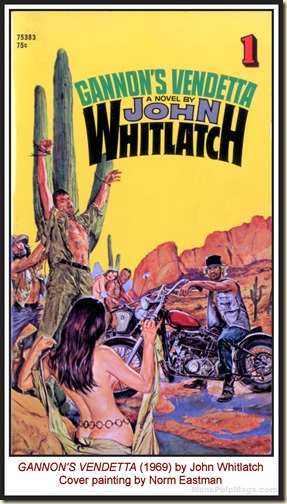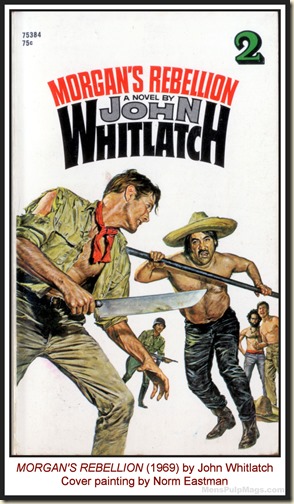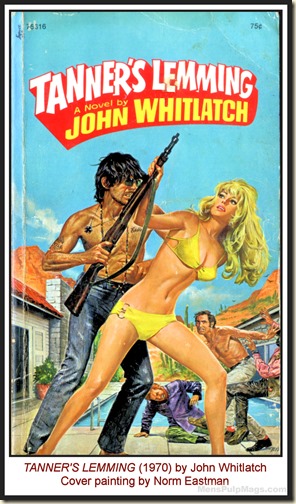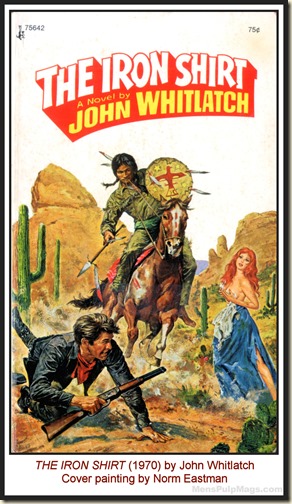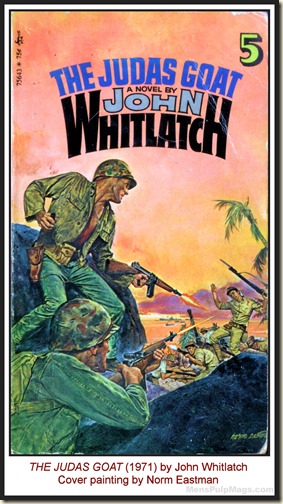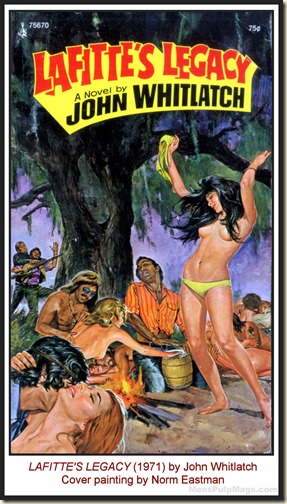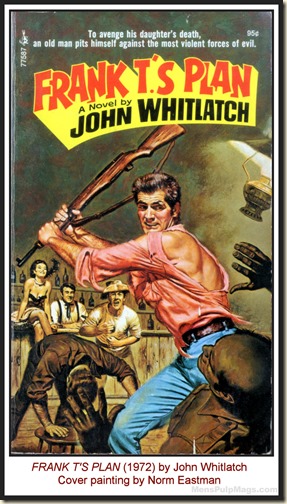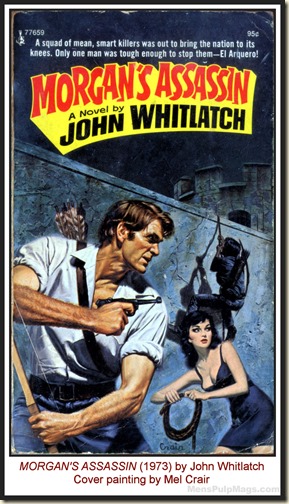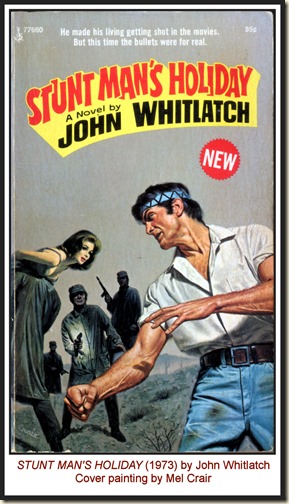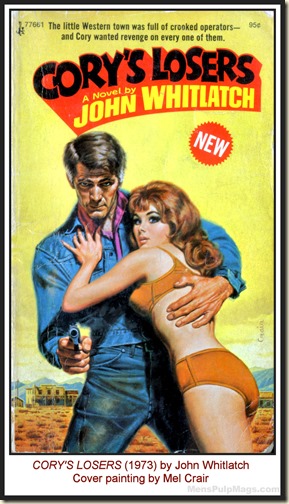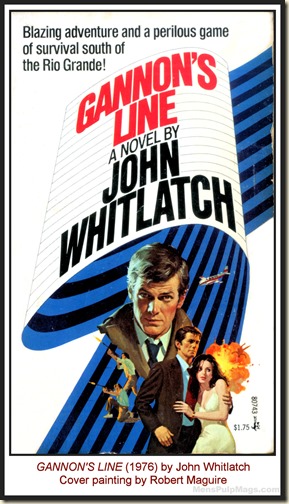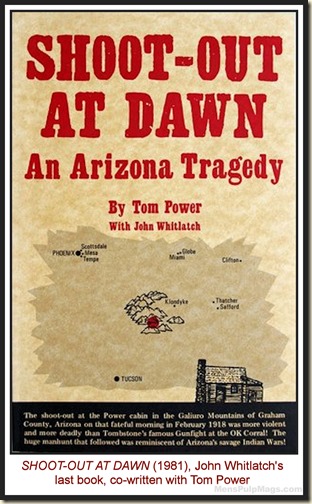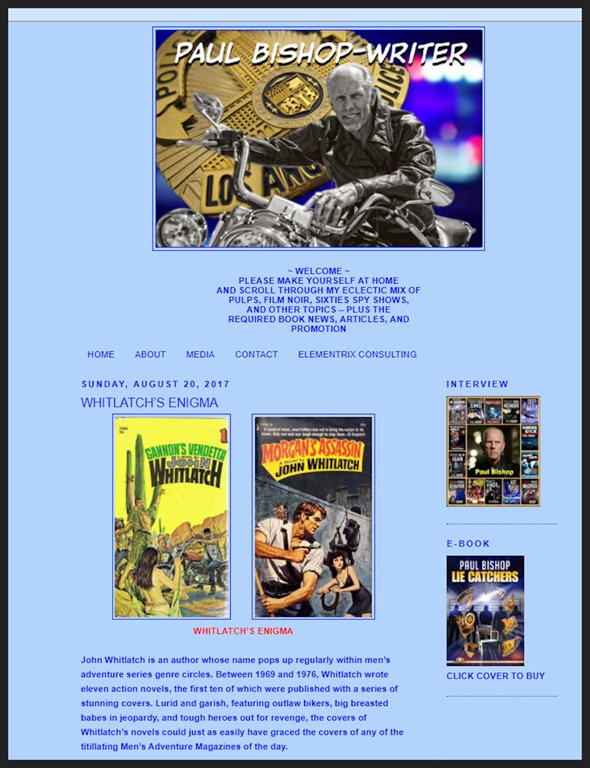
Updated on December 27, 2018…
EDITOR’S NOTE: A while back, I posted an interview here with a writer I’m a huge fan of and proud to call a friend: Paul Bishop. As I noted in that interview, Paul is an excellent and prolific novelist. His most recent novel is LIE CATCHERS, a highly-acclaimed police procedural with a special twist. Paul is also a veteran police detective, an editor and an indie publisher. On top of all that, he’s a serious action/adventure media maven who posts regularly about books, magazines, movies, TV shows, and people in the men’s adventure, Western, spy, mystery, and noir genres on his own blog, other sites, and in various men’s adventure-related Facebook groups, like the one associated with this blog and The Men’s Adventure Paperbacks of the 70s & 80s group.
One of Paul’s blog posts focused on the novels of a mysterious writer named John Whitlatch. In the late 1960s and early 1970s, Whitlatch wrote a series of gritty action/adventure novels that have gained a cult following, partly because they feature terrific cover paintings by two artists who did hundreds of illustrations for men’s adventure magazines and novels, Norm Eastman and Mel Crair, and partly because they are bloody good reads.
Exactly who John Whitlatch was remained an enigma to those of us who are his fans — until recently. After doing some initial research and a post about Whitlatch on his blog, Paul was contacted by someone who knew Whitlatch and gave Paul more information than existed anywhere online. Armed with that info, Paul wrote a new, in-depth post summarizing what he’d learned. I immediately asked him if I could repost it here, along with higher resolution scans of the covers than I’ve seen online (using my own copies of the Whitlatch novels) and an interesting review of his first two books I found using my Newspapers.com subscription. Paul said “yes.” So, here it is. Thanks, amigo! And, thanks again for the great Afterword you wrote for our book collecting men’s adventure magazine artwork featuring bikers and motorcycle gangs, BARBARIANS ON BIKES.
WHITLATCH’S ENIGMA: BY PAUL BISHOP
Jon Whitlatch is an author whose name pops up regularly within men’s adventure series genre circles. Between 1969 and 1976, Whitlatch wrote eleven action novels, the first ten of which were published with a series of stunning covers. Lurid and garish, featuring outlaw bikers, big breasted babe in jeopardy, and tough heroes out for revenge, the covers of Whitlatch’s novels could just as easily have graced the covers of any of the titillating Men’s Adventure Magazines of the day.
In actuality, the stunning covers of Whitlatch’s books first ten books were painted by top Men’s Adventure Magazine artists Norm Eastman (Gannon’s Vendetta, Lafitte’s Legacy, Tanner’s Lemming, Frank T’s Plan, The Judas Goat), and Mel Crair (Morgan’s Rebellion, Morgan’s Assassin, Stunt Man’s Holiday, Cory’s Losers. Men’s Adventure Magazine top model Steve Holland—The Face That Launched A Thousand Paperbacks—appears on several of the covers, adding to their collectability.
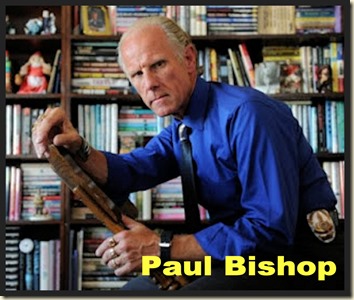 Unfortunately, Whitlatch’s last novel, Gannon’s Line, did not receive a similar instantly collectible cover. Instead, even though the small central illustration was by the great Robert Maguire, the cover design itself was generic and instantly forgettable.
Unfortunately, Whitlatch’s last novel, Gannon’s Line, did not receive a similar instantly collectible cover. Instead, even though the small central illustration was by the great Robert Maguire, the cover design itself was generic and instantly forgettable.
While the covers of Whitlatch’s books are often the catalyst for men’s adventure readers to buy and collect them, the writing between the covers is uniformly terrific. While definitely in sync with the attitudes and mores of the time period in which they were written, Whitlatch’s tales of every day guys caught up in deadly circumstances never failed to thrill.
A Whitlatch hero is a man pushed beyond the reasonable boundaries of civilization and is forced to find a core of inner strength to overcome overwhelming odds—in other words, a guy who you can unabashedly root for as he takes on outlaw motorcycle gangs, voodoo cults, tin-pot Latin dictators, sadistic Japanese troops in the Pacific Theater, Renegade Indians, and other megalomaniac villains.
Whitlatch’s books are straightforward contemporary actioneers. Even when writing a Western (Iron Shirt) or a WWII Dirty Dozen style tale (The Judas Goat), the narratives are straight out of the men’s adventure genre. This is not to say they are cookie cutter or by the numbers plots. Whitlatch’s writing elevates the tropes of the genre with excellent action scenes. His heroes are not supermen, but rugged individuals who face their fears and have the courage to not lay down and die.
For many years Whitlatch himself remained an total enigma. When asked about Whitlatch, regular genre resources and gurus were forced to shrug their shoulders and admit to their mystification at the lack of information.
Usually, this little information about an author would indicate the use of a house owned pseudonym, with a number of authors penning the tales. But, this doesn’t appear to be the case with Whitlatch. Having read all eleven novels, the distinctive tempo and sentence structure make it clear they were written by the same person.
About twenty years or more ago, I tried tracking Whitlatch through his publisher. I was put in touch with Whitlatch’s agent who informed me Whitlatch was deceased. He did, however, provide me with a contact number for his family, warning me they would probably not want to be interviewed.
I eventually made contact with Whitlatch’s sister in Arizona, but while polite, she refused to impart any information. A strange situation, especially coupled with a tid-bit from mystery historian Al Hubin, which noted there had been no copyright renewals on Whitlatch’s titles. This raised the odd possibility of Whitlatch or his work being seen as an embarrassment to his family.
My introduction to Whitlatch originally came through his second published title, Morgan’s Rebellion. This was a great adventure tale. The all-American everyman Jamey Morgan finds himself falsely imprisoned in Central America. Desperate and alone, he takes it upon himself to escape, rally the scattered rebel forces, and overthrow the corrupt regime in order to get his life back and revenge on his wife and business partner.
This was great stuff! Morgan was a cool character with his archery background and his righteous American indignation. Whitlatch is hardly politically correct and he wears the Mad Man style male chauvinist label proudly—definitely a product of his time—but the guy could write a rousing adventure
In 2009, I wrote about Whitlatch in a Forgotten Books post for my blog. At the time, in response to a blog post of his own, my buddy and prolific writer James Reasoner said, “You have to love the Internet.” In James’ case, his own blog post regarding a specific hardboiled author generated unexpected contact from one of the author’s surviving relatives.
In my case, several months after my post bemoaning the complete lack of information about John Whitlatch—beyond his novels and those lurid covers—I received a surprise email. It was from Bob Miller, a friend and former co-worker of Whitlatch’s who had somehow come across my original Whitlatch post. He offered to share information about the elusive author, whom he stated was a down-to-earth nice guy with a good sense of humor. I immediately scrambled to dial the provided phone and quickly found myself chatting with my informant.
Bob Miller told me he worked with Whitlatch in the 1960s when they were both claims adjusters for an insurance company working out of an office on Gower Street in Hollywood. Bob remained friends with Whitlatch, and was an ardent reader of his novels, until Whitlatch died in the late 1970s.
Apparently, Whitlatch was a force in the insurance business. He eventually became the head claims adjuster for All-State Insurance, working out of the company’s headquarters on Wilshire Boulevard in LA. Reportedly, he had a large, framed, picture of the All-State HQ building in Chicago hung on the wall behind his desk. The picture had a hand-drawn arrow pointing to one specific window in the building, which Whitlatch claimed was the office of the idiot I work for.
While working as a claims adjuster, Whitlatch also attempted to branch out into private business. For several years, he operated a self-service laundry on Ventura Boulevard—in the San Fernando Valley—with his wife, Geraldine. However, the business was forced into bankruptcy when long-term street repairs closed down easy access to the building.
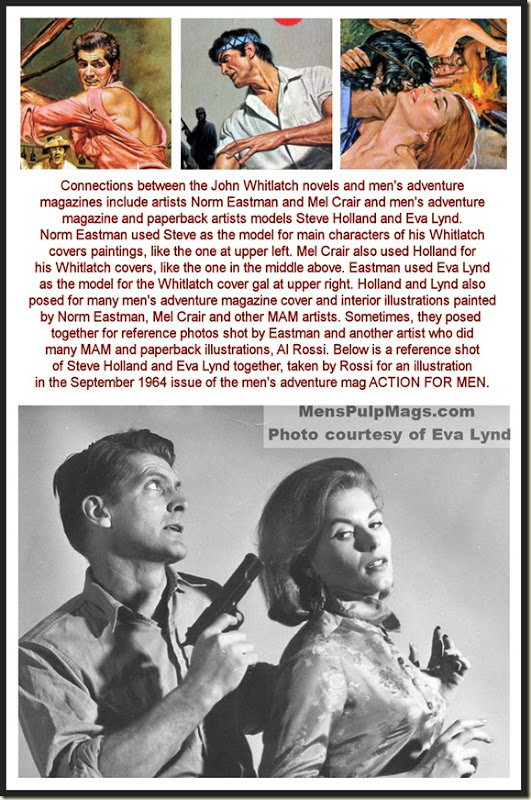 Crippled with a bad limp, Whitlatch didn’t let his physical infirmities keep him down. Miller remembers Whitlatch’s visits to the ranch where Miller’s father-in-law trained and bred horses. Whitlatch always managed to get around and showed an interest in everything.
Crippled with a bad limp, Whitlatch didn’t let his physical infirmities keep him down. Miller remembers Whitlatch’s visits to the ranch where Miller’s father-in-law trained and bred horses. Whitlatch always managed to get around and showed an interest in everything.
During the time of his visits to the stables, Whitlatch began writing spec movie scripts. Miller’s father-in-law had contacts in the movie industry via several of the horse owners for whom he bred and trained. He allowed Whitlatch access to those contacts and, while Whitlatch never sold a script, he received encouragement and praise for his writing.
On one stable visit, Whitlatch witnessed Miller’s father-in-law putting Vicks Vapor Rub in a mare’s nose in order to get her to accept a foal that wasn’t hers. The Vicks worked to distort the mare’s olfactory senses so she couldn’t tell the foal wasn’t her own. Whitlatch was to later use the scene in one of his novels.
A perfectionist when it came to insurance work, Whitlatch was a taskmaster—never letting correspondence or reports leave the office until they were letter perfect. But while he found insurance work financially rewarding, he longed to quit and write full time.
Miller remembers the day Whitlatch called him full of excitement. He had just sold his first two novels. Pocket Books had given him a contract for two of his completed manuscripts and planned to publish both novels simultaneously—a first for the publishing house.
Whitlatch eventually quit All-State to pursue his writing career. He had a handful of other novels published, but there was bad news on the horizon. Two years later, Miller received a phone call from his friend. Whitlatch told Miller he had been diagnosed with a brain tumor and had been given six month to two years to live.
Whitlatch’s final book, Shoot-Out At Dawn, was a non-fiction account of the deadly events at a remote Southern Arizona cabin in 1918. The book was written with Tom Power, one of the survivors of the clash. Whitlatch died shortly after it was published by Phoenix Books in 1981.
From other sources , it appears Whitlatch’s wife died sometime after 2005. The couple had no children. Clearly, Whitlatch will remain an enigma, but thanks to Bob Miller, those of us who have admired Whitlatch’s novels were finally given a glimpse into his background.
Here’s a brief look at what his men’s adventure novels are about, taken from the descriptions on the back covers…
GANNON’S VENDETTA (1969) — “Do not forget, gentlemen—violence is the only thing they understand. If in doubt, kill.” … Recalling with hatred all the blood and pain these cycle creeps had caused him, Gannon described his enemy to the men who had come to help him. The animals on the hopped-up Harleys had raped Gannon’s wife, torched his house, and then—after working him over—dumped him in the desert to die. They never expected Gannon to come out alive. This was the end of the long hunt–high noon at midnight. Gannon had followed the rat pack deep into Mexico. And now he was ready to do battle—their style.
MORGAN’S REBELLION (1969) — “Prison made a man of Morgan. And the man became a legend.” … Jamey Morgan—a quiet California citizen—was arrested on a business trip to Central America. Accused of aiding a revolution he knew nothing about, Morgan was deprived of all diplomatic rights, branded an international renegade, and sentenced to hard labor. And so, the only way he could return to the United States was to overthrow the government that imprisoned him. He made the revolution his own. After escaping from prison, Morgan fled into the hills and joined the rebel forces. An experienced bowman, he trained and organized an extraordinary guerrilla troop—Los Arqueros, the Archers—fifty rugged men on horseback, armed with bows and explosive arrows. The exploits of this daring commando unit help bring a ruthless dictatorship to its knees—and brought fame, love, and fortune to Captain Jamey Morgan.
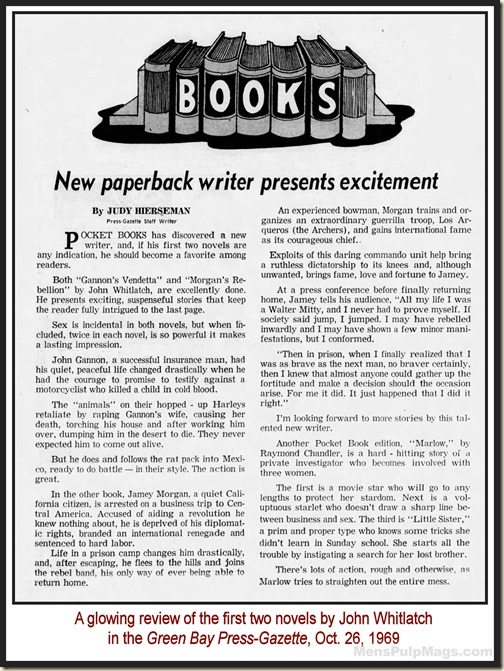 TANNER’S LEMMING (1970) — TANNER—the man who single-fistedly quashed a student takeover and tongue-lashed its leaders into silence at a turbulent school-board showdown. TANNER—the man who had never flown a plane, yet took the stick when a pilot died in midair and landed safely. TANNER—the man whose blunt business sense had won him a place in a Senator’s inner circle. TANNER—had he blown a hole in the heart of the man millions of Americans revered? Had he killed Senator Stanton? Could he have been the assassin?
TANNER’S LEMMING (1970) — TANNER—the man who single-fistedly quashed a student takeover and tongue-lashed its leaders into silence at a turbulent school-board showdown. TANNER—the man who had never flown a plane, yet took the stick when a pilot died in midair and landed safely. TANNER—the man whose blunt business sense had won him a place in a Senator’s inner circle. TANNER—had he blown a hole in the heart of the man millions of Americans revered? Had he killed Senator Stanton? Could he have been the assassin?
THE IRON SHIRT (1970) — Vengeance! Jonathan Fontaine swore it…in the smoking remains of his homestead, over the charred, mutilated body of his young daughter. He had gone East but now was back in Arizona with a specially equipped rifle. And he had a fresh lead on the Indian—the one who had worn a necklace of human fingers and The Iron Shirt…
LAFITTE’S LEGACY (1971) — Jean Larue returns the newspaper said…The last of the Latittes had come back from Arizona to visit his dying grandfather. But enemies lay in wait, blocking his way with fallen trees, terrorizing his wife with poisonous snakes, signaling their malice with voodoo dolls. Someone wanted the old treasure map that was his legacy. But his adversaries had not reckoned with the pirate blood that was also part of Lafitte’s legacy. He would tight with all the guile and guts, tenacity and ingenuity that had made his legendary ancestor the terror of the bayou.
THE JUDAS GOAT (1971) — Life had made them hard…The army made them mean! The attack squad…Hand-nicked from the entire U.S. World War II army, they were a unique company. Twelve men led by a lieutenant, as able as he was arrogant, and a sharp, seasoned sergeant who was militantly silent about his past. Twelve fighters. among them an ugly man, a black man, an old World War I scout, a southern redneck, and a mountain climber. They were a strange assortment, but they had several things in common—They were tough and tenacious…and they didn’t care too much about living. To the General they were the army’s answer to the marines. To the Colonel they were a crack team…the best he could assemble. To the lieutenant they were animals. And by the time their brutal training had ended they were killers.
FRANK T’S PLAN (1972) — Frank T. Dodge had a plan for revenge and it called for more than seeing a man dead… His daughter had been murdered…Frank T. had a painful score to settle. And his chance came when a jury freed the accused man, Martin Ballard. Lusting for vengeance, Frank T set out on a daring hunt to bring his prey back alive. But there was another group of desperate men who wanted Ballard dead. To get his man, Frank T would face death and terror with only his guts to get him through.
MORGAN’S ASSASSIN (1973) — They called him “El Arquero”… The history books said bows and arrows had gone out years ago. But nobody had told James Morgan. Armed only with his great longbow, he had led a revolution that freed a Central American nation from tyranny. His men were all arqueros, or archers, but he was the only one called “El Arquero.” Now, back in the States, Morgan received another call for help—from the F.B.I. This time it was to foil an assassination attempt that everyone else seemed powerless to stop. But then he discovered that he was next on the assassin’s list. It was kill or be killed—and as Morgan stalked his man, he discovered he was up against the most diabolical political conspiracy America had ever seen. To defeat it, the arqueros would have to march again…
 STUNT MAN’S HOLIDAY (1973) — Max Besh was one tough apache. They shouldn’t have gotten him mad. Max Besh, movie stunt man arid full-blooded Apache, was having quite a vacation in Las Vegas. He’d wan six grand at the crap tables and he’d gotten himself a curvy young dancer for companionship. Next thing he knew, he was looking down the barrel of a .38 and somebody was riding off with the cash and the girl. What the kidnappers didn’t realize was nobody pulls that kind of trick on Max Besh. They eluded police and crossed the Mexican border, but they couldn’t shake the angry Indian on their trail. Even if it took a shootout, Max Besh was going to get his money and his woman back—in that order.
STUNT MAN’S HOLIDAY (1973) — Max Besh was one tough apache. They shouldn’t have gotten him mad. Max Besh, movie stunt man arid full-blooded Apache, was having quite a vacation in Las Vegas. He’d wan six grand at the crap tables and he’d gotten himself a curvy young dancer for companionship. Next thing he knew, he was looking down the barrel of a .38 and somebody was riding off with the cash and the girl. What the kidnappers didn’t realize was nobody pulls that kind of trick on Max Besh. They eluded police and crossed the Mexican border, but they couldn’t shake the angry Indian on their trail. Even if it took a shootout, Max Besh was going to get his money and his woman back—in that order.
CORY’S LOSERS (1973) — When Cory had been stuck with that had murder rap, some of the town’s solid citizens had moved in and taken everything he had. Now it was seven years later, and Cory was back with a score to settle. Meanwhile, his enemies had become the most powerful, ruthless men in town. They knew Cory was coming, and they were ready for him. But Cory had friends—the losers who, like him, had been taken by the big honchos. Together, they were going to make things pretty hot for those crooked bastards…
GANNON’S LINE (1976) — John Gannon had settled into the life he wanted as foreman of the Holguin Rancho, south of Sonora. But powerful people in Washington had singled him out to lead a band of men and horses into the scorching Baja desert. His mission: to locate in that inferno of sand and sun the secret base of an espionage ring—and to crush the sadistic genius who masterminded it.
* * * * * * * * * *
EDITOR’S POSTSCRIPT: When I scanned the paperback covers for this post, I noticed a connection between the John Whitlatch novels and men’s adventure magazines that I hadn’t noticed before. As Paul Bishop noted in his post, most of the novel covers were done by two top MAM artists, Norm Eastman and Mel Crair. Eastman and Crair both used the great male model Steve Holland as main characters for their Whitlatch covers, as they often did for their men’s adventure mag illustrations.
When I scanned the cover of LAFITTE’S LEGACY, painted by Norm Eastman, it struck me that the gal getting nuzzled in the bottom left corner of the cover looked a lot like my friend Eva Lynd, who was both an artist’s model and pinup photo model back in the day. In fact, she was one of Eastman’s favorite female models for his men’s adventure art.
I emailed a scan of the LAFITTE’S LEGACY cover to Eva and she confirmed that Norm had used a reference photo of her for the nuzzled gal. As I’ve discussed in other posts on this blog, Eva often posed together with Holland for reference photos taken by Eastman and another artist who did many MAM and paperback illustrations, Al Rossi. To read and see more about Eva Lynd and Steve Holland together, click this link.
* * * * * * * * * *
Comments? Corrections? Post them on the Weasels Ripped My Book Facebook Page, email them to me,
or join the Men’s Adventure Magazines & Books Facebook Group and post them there.


